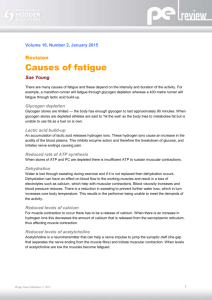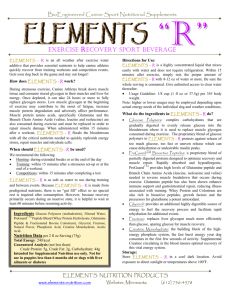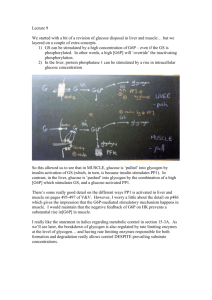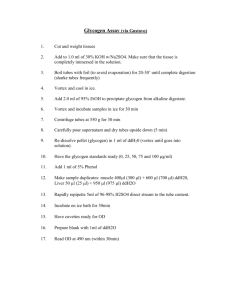Muscle metabolism during fatiguing exercise
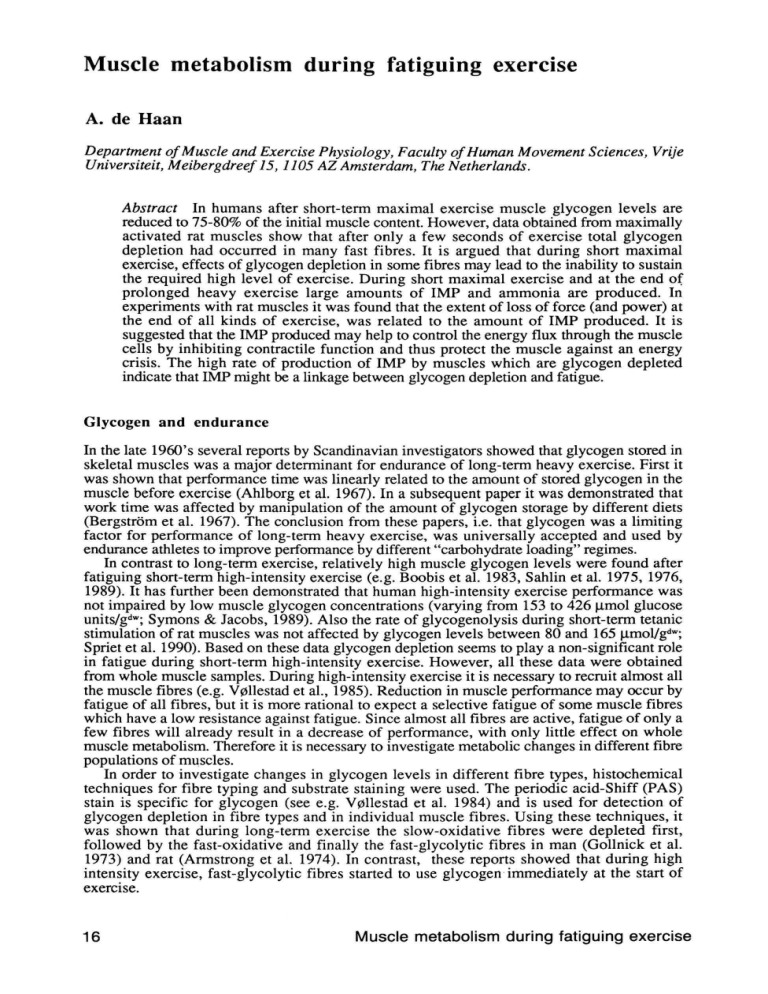
MuscIe metabolism during fatiguing exercise
A. de Haan
Department of Muscle and Exercise Ph y siology, Faculty of Human Movement Sciences , Vrije
Universiteit, Meibergdreef 15, 1105 AZ Amsterdam, The Netherlands .
Abstract In humans af ter short-term maximal exercise muscle glycogen levels are reduced to 75-80% of the initial muscle content. However, data obtained from maximally activated rat muscles show th at after only a few seconds of exercise total glycogen depletion had occurred in many fast fibres . It is argued that during short maximal exercise, effects of glycogen depletion in some fibres may lead to the inability to sustain the required high level of exercise. During short maximal exercise and at the end of prolonged heavy exercise large amounts of IMP and ammonia are produced. In experiments with rat muscles it was found that the extent of loss of force (and power) at the end of all kinds of exercise, was related to the amount of IMP produced . It is suggested that the IMP produced may help to con trol the energy flux through the muscle cells by inhibiting contractile function and thus proteet the muscle against an energy crisis. The high rate of production of IMP by muscles which are glycogen depleted indicate that IMP rnight he a linkage between glycogen depletion and fatigue .
Glycogen and endurance
In the late 1960's several reports by Scandinavian investigators showed that glycogen stored in skeletal muscles was a major determinant for endur a nce of long-term heavy exercise. First it was shown th at performance time was linearly related to the amount of stored glycogen in the muscle before exercise (Ahlborg et al. 1967) . In a subsequent paper it was demonstrated th at work time was affected by manipulation of the amount of glycogen storage by different diets
(Bergström et al. 1967) . The conclusion from these papers, i.e
. that glycogen was a lirniting factor for performance of long-term heavy exercise , was universally accepted and used by endurance athletes to improve performance by different "carbohydrate loading" regimes.
In contrast to long term exercise, relatively high muscle glycogen levels were found af ter fatiguing short-term high-intensity exercise (e .
g . Boobis et al. 1983, Sahlin et al . 1975, 1976,
1989) . It has further been demonstrated that human high-intensity exercise performance was not impaired by low muscle glycogen concentrations (varying from 153 to 4261lmol glucose units/gdw; Symons & Jacobs, 1989). Also the rate of glycogenolysis during short-term tetanic stimulation of rat muscles was not affeeted by glycogen levels between 80 and 165 Ilmol/gdw;
Spriet et al. 1990) . Based on these data glycogen depletion seems to play a non-significant role in fatigue during short-term high intensity exercise . However, all these data were obtained from whole muscle sample s . During high-intensity exercise it is necessary to recruit almost all the muscle fibres (e .
g . V!1Illestad et al., 1985). Reduction in muscle performance may occur by fatigue of all fibres, but it is more rational to expect a selective fatigue of some muscle fibres which have a low resistance against fatigue. Since a lmo s t all fibres are active, fatigue of only a few fibres will already result in a decrease of performance, with only little effect on whole muscle metabolism. Therefore it is necessary to investigate metabolic changes in different fibre populations of muscles .
In order to investigate change s in glycogen levels in different fibre types, histochemical techniques for fibre typing and substrate staining were used. The periodic acid-Shiff (PAS) stain is specific for glycogen (see e .
g . V !1I
llestad et al. 1984) and is used for detection of glycogen depletion in fibre types and in individual muscle fibres . Using these techniques , it was shown th at during long-term exercise the slow-oxidative fibres were depleted first, followed by the fast oxidative and finally the fast glycolytic fibres in man (Gollnick et al.
1973) and rat (Armstrong et al. 1974) . In contrast, these reports showed that during high intensity exercise , fast-glycolytic fibres started to use glycogen immediately at the start of exercise .
16
Muscle metabolism during fatiguing exercise
Control
Experlmental
.0 c:(
en
C
'"
I en c:(
CL.
0)
C c
0
;:
Co
~
15
12
UA UB
,;.
., a
....
Red gastrocnemlus
15
UA IIB
12 y. 0
~.
iI·
0 10 20 30 40 50 60 70 80
0 10 20 30 '0 50 SO 70 80
Absorption ATPase (acid pre-Incub)
Whlte gastrocnemius
15
12
20
IIBd
15
12
IIBm IIBd IIBm
30
•
' 0 50 60 70
0
20 30
..
•
.0 50
A.r ••
60
Absorptlon ATPase (fixed alkaline pre-Incub)
70
Figure 1. Example of changes in PAS-absorption in different fibre types in red and white rat medial gastrocnemius muscles.
The experimental muscle was maximally stimulated to perform 40 successive dynamic contractions within lOs (see group C in Fig. 3). The controls were resting contralateral muscles . The fibres were classified according to Lind & Kernell (1991). The absorption data are given in arbitrary units . These experiments were performed in collaboration with
A.Lind and D.Kernell of the Department of Neurophysiology, University of Amsterdam,
The Netherlands.
In a recent study we investigated glycogen degradation in fibres of in situ medial gastrocnemius muscles. These muscles of anaesthetized rats were maxima11y stimulated (lmA;
120Hz) at a temperature of 36°C using an isovelocity measuring device (de Haan et al . 1989) .
The muscles performed 40 dynamic contractions (duration 84ms) within lOs. During the lOs exercise (tota! active duration: 3.4s) work output per contraction decreased to <10% of the output in the fITst contraction (see group C in Fig. 3). At the end of the exercise the muscles were frozen in isopentane pre-cooled in liquid nitrogen. 10Ilm sections were cut from the midsection of the muscles and stained for fibre typing and PAS . Identification of fibre types I,
I1A, IIBd and IIBm occurred as described by Lind & Kernell (1991) by a combination of
ATPase stainings af ter an acid pre-incubation (Brooke & Kaiser, 1970) and af ter a fixed alkaline pre-incubation (Guth & Samaha, 1970).
A. de Haan
17
Figure 1 presents examples of PAS absorption measurements of fibres in resting and exercised muscles. In the red portion of the gastrocnemius muscle all 4 fibre types are present, while in the white portion of the muscle only types IIBd and IIBm are seen (Fig. 1) . Although all fibres were maximally stimulated, glycogen utilization (as judged by the change in PAS absorption) was most pronounced in the type IIBm fibres and hardly any changes in PAS absorption occurred in the type I fibres . These data show that in rats severe glycogen depletion of fast fibres can occur in short duration maximal exercise of only a few seconds. Differences exist between rats and humans with respect to total content of glycogen and possibly in maximal rates of glycogen degradation. Nevertheless, effects resulting from glycogen depletion may play also a role in fatigue during short-term high-intensity exercise in humans. This is supported by the observations of Gollnick et al. (1974) who showed that af ter the fITst exercise bout (3min at 120% VÜ2max) some FT fibres were al ready glycogen depleted.
Glycogen depletion patterns and motor unit recruitment
The data in Fig. 1 show th at the absence of a change in PAS-absorption in slow fibres (Type I) does not necessarily mean that these fibres were not active during exercise, because in this preparation all fibres were maximally activated. Thus although during high-intensity exercise in humans only little evidence of glycogen oxidation is seen in the slow-twÏtch fibres (Gollnick et al. 1973), one cannot conclude that those fibres had not been active during this type of exercise . Clearly care is needed in interpreting glycogen depletion patterns in terms of fibre activity (and fibre recruitment). The relation between glycogen depletion patterns and fibre activity may also be disturbed by the existence of differences between fibres with respect to the possibilities of utilizing other substrates (like free-fatty acids and amino acids) as weil as glycogen for ATP generation. Moreover, some reports suggest that also non-exercising muscles in the rat may utilize glycogen at a similar rate as the exercising muscles (McDermott et al. 1987, Bonen 1989). In these studies comparison was made between the changes in glycogen levels of rat hindlimb muscles af ter treadmill exercise with and without hindlimb suspension. All types of muscle (white gastrocnemius as weil as soleus muscle) showed similar glycogen degradations irrespective of their activity. They further showed that the loss of glycogen in the non-exercising muscles was dependent on the increase in the plasma epinephrine concentration (McDermott et al. 1987). This dependency on epinephrine is in agreement with earlier reports from Gorski et al. (1978) and Richter et al. (1981, 1982). They suggested th at the first enhancement of glycogen utilization during exercise is induced by the onset of contractile activity, but that later in the exercise epinephrine is necessary to maintain an enhanced rate of degradation . The findings that muscles which had not been activated also showed glycogen degradation further demonstrates, th at one should be careful with using glycogen depletion pattems to study motor-unit recruitment patterns during exercise .
Glycogen depletion and fatigue: why?
In spite of the enormous attention given to glycogen oxidation and fatigue, it remains unclear why low glycogen levels results in fatigue. The most popular theory on why glycogen is necessary for ATP production is the anaplerotic theory (Conlee 1987). According to this theory glycogen oxidation provides pyruvate, which can be used for reactions to supply intermediates of the tricarboxylic acid (TCA) cycle . Oxaloacetate can be formed by carboxylation of pyruvate
(by pyruvate carboxykinase) and of phosphoenolpyruvate (PEP; by PEP carboxykinase) . a-Ketoglutarate can be formed by the aminotransferase reaction, where pyruvate is converted to alanine at the expense of glutamate (by Glutamate Pyruvate Transaminase). During shortterm high-intensity exercise (Essén & Kayser 1978) and during the first minutes of prolonged exercise there is an increase in the amount of TCA cycle intermediates (TCAI; Sahlin et al.
1990) . An increase in TCAI is needed to obtain a high flux through the cyc1e, which is necessary to feed the mitochondria with reduction equivalents (NADH) for the respiratory chain . During prolonged exercise a decrease of TCAI is observed (Sahlin et al. 1990) .
It has been suggested that degradation of branched-chain amino acids (BCAA) is one of the major reactions which leads to draining of intermediates from the TCA cycle (Wagenmakers et al. 1991) . Through activation of the branched-chain 2-oxo acid dehydrogenase complex,
BCAA are converted to 2-oxo acids, while a-ketogluterate is aminated to glutamate. Glutamate
18 Muscle metabolism during fatiguing exercise
AMP
AMP deaminase
Adenylo-
Succlnate
(AS)
IMP
Aspartate
Figure 2. The Purine Nucleotide Cycle (Lowenstein 1972). can then be used to fonn glutamine or alanine (by the Glutamate Pyruvate Transaminase reaction). The release of glutamine and alanine from the muscles during pro10nged exercise
(Sahlin et al. 1990) indicate that draining of TCAI occurs. Thus, in order to maintain a high flux through the TCA cycle it is necessary to remain supplying the TCA cycle with intennediates. It has been suggested that when muscIe glycogen is depleted, the supp1y of pyruvate will be reduced 1eading to a limitation of anap1erotic reactions. Because of the resulting decrease in maximal rate of A TP production transient increases in ADP and AMP will occur, which will then lead to contractile failure (Sahlin et al. 1990).
Purine Nucleotide Cycle and fatigue
It was further argued that the occurrence of transient increases in ADP and AMP was supported by the observed increases in inosine-5' -monophosphate (IMP) and ammonia, because ADP and AMP are both activators of the enzyme AMP-dearninase (Sahlin et al. 1990) .
This reaction is part of the purine nucleotide cycle (PNC; Fig . 2; Lowenstein 1972), which cycle is active during exercise (Aragon & Lowenstein 1980). There are several functions suggested for the PNC (Tullson & TeIjung 1989; Lowenstein 1972, 1990):
1. During one complete cycle one aspartate is deaminated to fumarate . Thus the cycle can provide TCAI from arnino acid sources and thus support the replenishment of TCA cycle intennediates. Because of the relatively low activities of the enzymes for reamination of
IMP to AMP this replenishment probably does not occur during short maximal exercise.
In the other suggested functions only the AMP dearninase reaction is involved.
2 . One of the main functions is thought to be the con trol of relative concentrations of A TP,
ADP and AMP . The maintenance of a relatively high ATP/ADP ratio (and phosphorylation potential) is important for many cellular reactions .
3 . Produced NH3 may take up H+-ions and thus serve as a pH-buffer . NH3 is also an activator of phosphofructokinase and hence glycolysis.
4. Produced IMP may stimulate glycogen degradation by activation of the enzyme phosphory1ase b .
A. de Haan 19
Figure 3. Changes in work output (mean
±
SD) during exercise.
Rat medial gastrocnemius muscles were maximally stimulated to petform a series of contractions within lOs.
Group A ( .
. ): 10 contractions (duration 342ms shortening velocity (v) 8Omm/s) .
Group B (0): 25 contractions (duration 134ms: v=5Omm/s).
Group C (0): 40 contractions (duration 84ms : v=80mm/s) .
Total stimulation time was -3.4s in all groups . Shortening distance was 6mm (-17% of the muscIe belly length). (Data from de Haan, 1990).
All these suggested functions will help to preserve a high rate of ATP production in order to sustain the exercise . For living cells it is important to con trol the energy flux and thus to maintain a balance between A TP producing and ATP utilizing processes . Occurrence of an imbalance may result in loss of main cell functions and necrosis. Therefore muscle cells should not only con trol A TP producing reactions but should also con trol ATP utilizing processes (as contractile activity).
It has been suggested that the production of IMP may play a role in the control of contractile activity and thus serve as a protecting mechanism (Berden et al. 1986 ; Westra et al. 1986). It has been shown that the loss of force during one continuous or during series of repeated isometric or dynarnic contractions co-incided with an increase in muscle IMP content (Westra et al. 1986; de Haan et al. 1988, 1991). In recent experiments different protocols of short-term high-intensity exercise of rat medial gastrocnemius muscles lead to different extents of loss of petformance (Fig . 3) . In groups A, Band C the muscles petformed 10, 25 and 40 contractions within lOs with shortening velocities of 20, 50 and 8Omm/s, respectively .
Total stimulation time during the lOs exercise was 3 .
4s in all protocols. Whereas -90% of the initial work output was lost at the end of the exercise in groups Band C, the loss of work output was only -35% in group A (Fig . 3). MuscIe phosphocreatine and lactate concentrations at the end of exercise were similar for the 3 groups (Tabie 1) . However, reductions in A TP and concommitant productions of IMP were higher for the 2 groups with the greatest loss of petformance. The very high lMP concentrations af ter exercise in group C correspond with the large depletion of glycogen found at the end of this exercise (Fig. 1). Formation of IMP and
NH3 in glycogen depleted muscles and fibres have also been reported for human muscles
(Norman et al . 1988; Spencer et al. 1991; Broberg & Sahlin 1989) .
20
Muscle metabolism during fatiguing exercise
Table 2.
Metabolite concentrations of resting muscles (Control) and of muscles sampled af groups. (Data from de Haan, 1990)
PC
ATP
ADP
IMP
Lactate
Control
(n=18)
100 .
6
(4 .
7)
29.7
(2.3)
4.3
(0.2)
<1
8.4
(2.4)
Group A
(n=6)
37.6
(5.1)
20.1
(2 .
2)
5 .
0
(0.2)
9.9
(2.1)
54.6
(10.1)
Group B
(n=6)
31.2
(7 .
2)
11.0
(1.2)
4 .
0
(0 .
7)
18 .
6
(1.2)
56.7
(5.1)
Group C
(n=6)
33 .
8
(7.5)
11.6
(l.2)
4.3
(0.3)
17 .
8
(l.7)
57.2
(6 .
5)
Mean data (SD) are given in IlmoVgdw
It can he hypothetized therefore that severe depletion of glycogen would result in an increased formation of IMP, which compound would inhibit contractile activity. This hypothesis is supported by recent in vitro experiments which showed th at IMP inhibits actinstimulated myosin A TPase activity (Westra et al. 1992) .
In conclusion, it is suggested that effects of glycogen depletion may play a role in fatigue during short-duration high-intensity exercise. Further, it is suggested that depletion of glycogen may lead to increased IMP levels , which would inhibit contractile function and thus lead to fatigue.
References
Ahlborg B, Bergström I, Ekelund, G and Hultman E (1967). Muscle glycogen and muscle electrolytes during prolonged physical exercise. Acta Physiologica Scandinavia 70: 129-
142
Aragón IJ & Lowenstein JM (1980) . The purine nucleotide cycle. Comparison of the levels of citric acid cycle intermediates with the operation of the purine nucleotide cycle in rat muscle during exercise and recovery from exercise. European Journalof Biochemistry
110 : 371-177.
Armstrong RB, Saubert CW, Sembrowich WL, Shepherd RE and Gollnick PD (1974).
Glycogen depletion in rat skeletal muscle fibers at different intensities and durations of exercise . Pflügers Archiv 352: 243-256.
Berden IA, de Haan A, de Haan EI, van Doorn JE, Hartog AF and Westra HG (1986). Has
IMP a regulatory role during fatiguing contraction? IMP-binding sites on the myosin complex of rat muscle. Journalof Physiology 381: 85P .
Bergström I, Hermansen L, Hultman E and Saltin B (1967). Diet, muscle glycogen and physical performance. Acta Physiologica Scandinavia 71 : 140-150 .
Bonen A, McDermott IC and Hutber CA (1989). Carbohydrate metabolism in skeletal muscle : an update of current concepts. International Journalof Sports Medicine 10: 385-401.
A. de Haan 21
Boobis LH, Williams C and Wootton SA (1983) . Human muscle metabolism during brief maximal exercise. Journal of Physiology 338 : 21-22P .
Broberg S & Sahlin K (1989). Adenine nucleotide degradation in human skeletal muscle during prolonged exercise. Journalof Applied Physiology 67 : 116-122.
Brooke MH & Kaiser KK (1970). Muscle fiber types: How many of what kind? Archives
Neurology 23: 369-379.
Con lee RK (1987) . Muscle glycogen and exercise endurance: A twenty-year perspective.
Exercise and Sports Sciences Reviews 15: 1-29 . de Haan A, van Doom JE and Sargeant AJ (1988) . Age-related changes in power output during repetitive contractions of rat medial gastrocnemius muscle. Pflügers Archiv 412:
665-667. de Haan A, Jones DA and Sargeant AJ (1989). Changes in velocity of shortening, power output and relaxation rate during fatigue of rat medial gastrocnemius muscle . Pflügers
Archiv 413: 422-428. de Haan A (1990). High-energy phosphates and fatigue during repeated dynamic contractions of rat muscle . Experimental Physiology 75,851-854. de Haan A, de Ruiter CJ and Sargeant AJ (1991) . Influence of age on fatigue, IMP production and efficiency. Abstract: Proceedings of the 8th International Biochemistry of Exercise
Conference, Nagoya, Japan
Essén B & Kayser L (1978). Regulation of glycolysis in intermittent exercise in man. Journal
of Physiology 281: 499-511.
Gollnick PD, Piehl K and Saltin B (1974). Selective glycogen depletion patterns in human muscle fibres af Journalof
Physiology 241 : 45-57.
Gollnick PD, Armstrong RB, Sembrowich WL, Shepherd RE and Saltin B (1973) . Glycogen depletion patterns in human skeletal muscle fibers after heavy exercise . Journalof
Applied Physiology 34 : 615-618.
Górski J (1978) . Exercise-induced changes of reactivity of different types of muscle on glycogenolytic effect of adrenaline . Pflügers Archiv 373: 1-7 .
Guth L & Samaha FJ (1970) . Procedure for the histochemical demonstration of actomyosin
ATPase . Research note. Experimental Neurology 28: 365-367.
Lind A & KernelI D (1991) . Myofibrillar ATPase histochemistry of rat skeletal muscles: a twodimensional quantitative approach. The Journalof Histochemistry and Cytochemistry
39: 589-597 .
Lowenstein JM (1972) . Ammonia production in muscle and other tissues: !he purine nucleotide cycle. Physiological Reviews 52: 382-414.
Lowenstein JM (1990) . The purine nucleotide cycle revised. International Journalof Sports
Medicine 11 (suppl. 2): S37-S46.
McDermott JC, Elder GCB and Bonen A (1987) . Adrenal hormones enhance glycogenolysis in non-exercising muscle during exercise. Journalof Applied Physiology 63: 1275-1283.
Norman B, Sollevi A and Jansson E (1988). Increased IMP content in glycogen-depleted muscle fibres during submaximal exercise in man . Acta Physiologica Scandinavia 133:
97-100.
Richter EA, Ruderman NB, Gravas H, Belur ER and Galbo H (1982). Muscle glycogenolysis during exercise : dual control by epinephrine and contraetions. American Journal of
Physiology 242 : E25-E32 .
Richter EA , Galbo Hand Christen sen NJ (1981) . Con trol of exercise-induced muscular glycogenolysis by adrenal medullary hormones in rats. Journalof Applied Physiology
50: 21-26 .
Sahlin K, Broberg S and Ren JM (1989) . Formation of IMP in human skeletal muscle during incremental dynamic exercise. Acta Physiologica Scandinavia 136: 193-198.
Sahlin K, Harris RC and Hultman E (1975). Creatine kinase equilibrium and lactate content compared with muscIe pH in tissue samples obtained af ter isometrie exercise.
BiochemicalJournal152: 173-180.
Sahlin K, Harris RC, Nylind Band Hultman E (1976). Lactate content and pH in muscle samples obtained after dynamic exercise . Pflügers Archiv 367 : 143-149.
Sahlin K, Katz A and Broberg S (1990) . Tricarboxylic acid cycle intermediates in human muscle during prolonged exercise . American Journal of Physiology 259: C834-C841.
22 Muscle metabolism during fatiguing exercise
Spencer MK, Yan Zand Katz A (1991) . Carbohydrate supplementation attenuates IMP formation in human muscIe during prolonged exercise. American Journal of Physiology
261: C71-C76.
Spriet LL, Berardinucci L, Marsh DR , Campell CB and Graham TE (1990) . Glycogen content has no effect on skeletal muscIe glycogenolysis during short term tetanie stimulation.
Journalof Applied Physiology 68 : 1883-1888.
Symons JD & Jacobs 1(1989) . High-intensity exercise performance is not impaired by low intrarnuscular glycogen. Medicine and Science in Sports and Exercise : 21 : 550-557 .
Tullson PC & Terjung RL (1991). Adenine nucleotide metabolism in contracting skeletal muscIe. Exercise and Sports Sciences Reviews 19, 507-538.
Vj.}llestad NK, Vaage 0 and Hermansen L (1984) . MuscIe glycogen depletion patterns in type I and subgroups of type 11 fibres during prolonged severe exercise in man. Acta
Physiologica Scandinavia 122 : 433-44l.
Vj.}llestad NK & Blom PCS (1985) . Effect of varying exercise intensity on glycogen depletion in human muscIe fibres . Acta Physiologica S c andinavia 125 : 395, 405 .
Wagenmakers AJM , Beekers EJ , Brouns F, Kuipers H , Soeters PB, van der Vusse GJ and
Saris WHM (1991) . Carbohydrate supplemention , glycogen depletion, and amino acid rnetabolism during exercise . American Journalof Physiology 260: E883-E890 .
Westra HG , de Haan A, van Doorn JE and de Haan EJ (1986) . IMP production and energy metabolism during exercise in rats in reIation to age. Biochemical Journal239 : 751-755 .
Westra HG, Berden JA and Pasman WJ (1992) . A model for regulation of actin activated myosin ATPase inhibition of the formation of actin-myosin complex . In : Sargeant AJ &
Kernell D (Eds) . Neuromuscular Fatigue . Royal Netherlands Academy of Sciences -
Elsevier Biomedical BV , Amsterdam, The Netherlands.
A. de Haan 23
